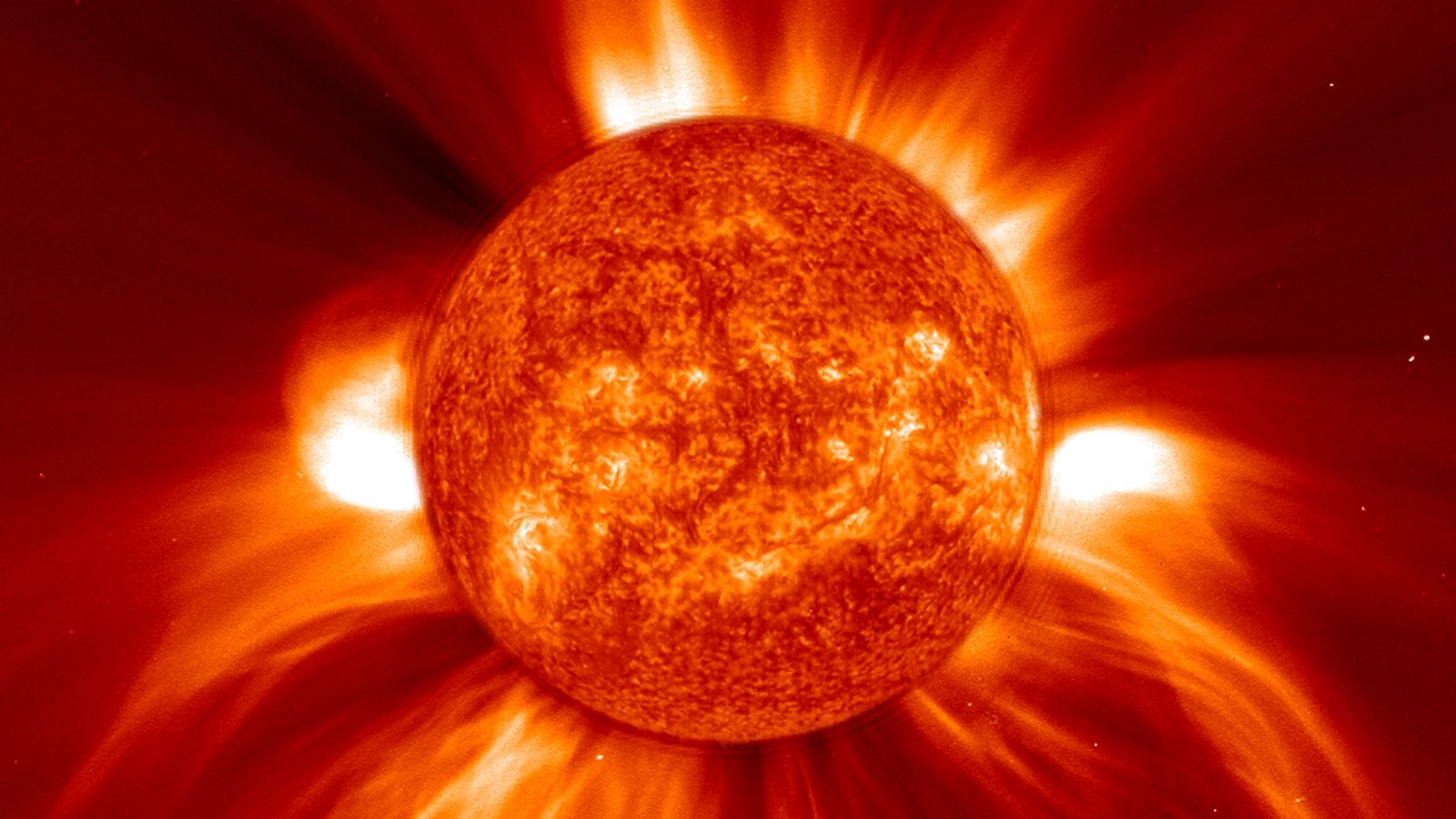
Components of the Solar System
- Our solar system consists of the sun, eight major planets, dwarf planets (Pluto, Ceres, Eris etc.), satellites and countless minor planets, asteroids, meteors, comets and debris.
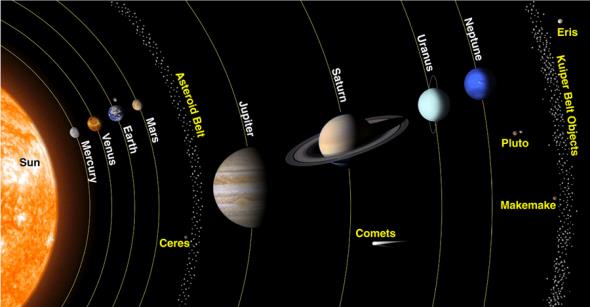
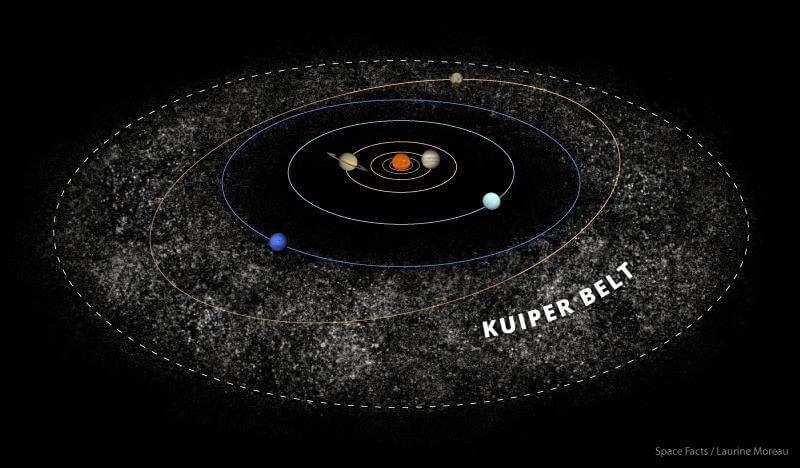
Components of the Solar System
The Sun
- Age: 4.6 billion years.
- Diameter: 1.39 million km.
- Temperature: 6000 °C on surface and 16 million °C in core.
- Density: 1.41 times that of water.
Density of water = 999.97 kg/m³ = ~ 1 g/cm3;
Density of Iron = 7870 kg/m³.
That implies Iron is = 7.87 times denser than water. In comparison, earth is about 5.5 times denser than water.
- The surface gravity of the Sun is 274 m/s2 (28 times the gravity of the Earth).
- Comparatively, the surface gravity of the earth and moon are 9.8 m/s2 and 1.62 m/s2 respectively.
- Period of rotation: 25 days 9 hrs.
- Speed of rotation: 7179.73 km/hrs. Comparatively, earth’s rotational velocity is 1675Km/hrs.
- Sun is equivalent to 3,32,900 Earth masses.
- Stars like Sun are rare in Milky Way galaxy, whereas substantially dimmer and cooler stars, known as red dwarfs, are common.
- The Sun is composed of roughly 98% hydrogen and helium.
- The vast majority of the solar system’s mass is in the Sun (~99.8%), with most of the remaining mass contained in Jupiter and Saturn.
- Although the Sun dominates the system by mass, it accounts for only about 2% of the angular momentum due to the differential rotation within the gaseous Sun.
- Sun is rotating in counter-clockwise direction (when viewed from a long way above Earth’s north pole).
- Those objects closer to the Sun, which are more affected by heat and light pressure, are composed of elements with high melting points.
- Objects farther from the Sun are composed largely of materials with lower melting points.
The Sun’s Internal Structure and Atmosphere
- The solar interior, from the inside out, is made up of the core, radiative zone and the convective zone.
- The solar atmosphere above that consists of the photosphere, chromosphere, and the corona (solar wind is an outflow of gas from the corona).
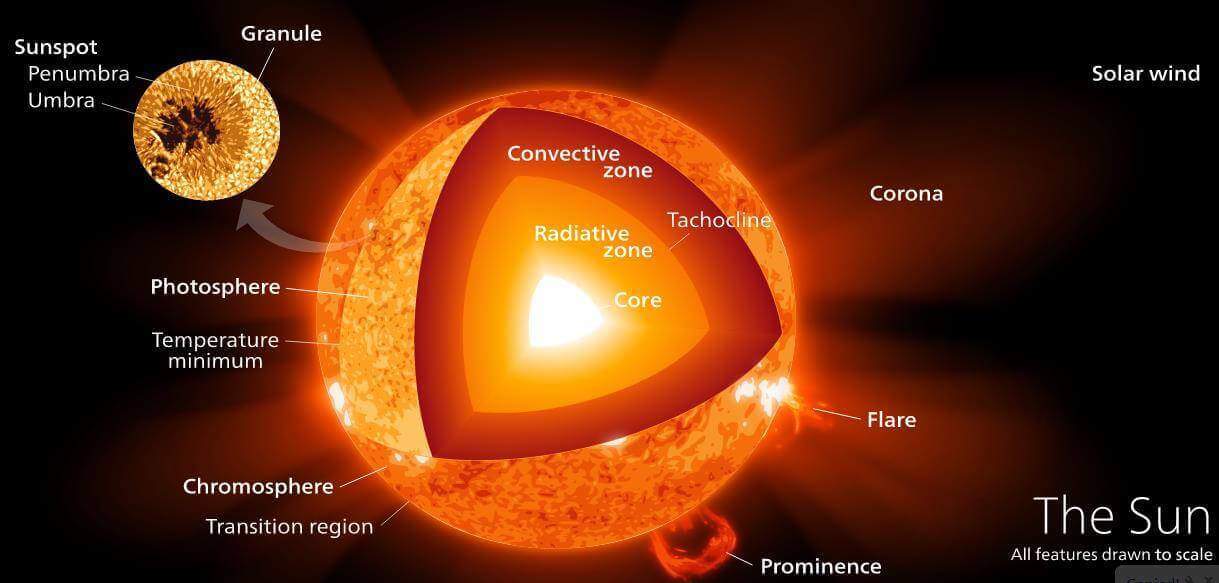
The Sun’s Internal and External Structure
- The photosphere is the bright outer layer of the Sun that emits most of the radiation.
- The photosphere is an extremely uneven surface.
- The effective temperature on the outer side of the photosphere is 6000°C.
- Just above the photosphere is the chromosphere.
- It is relatively a thin layer of burning gases.
- The chromosphere is a bit cooler — 4,320 ֯C.
- A dark patch on the surface of the Sun is known as a sunspot.
- Sunspots appear as dark areas because they are about 500-1500°C cooler than the surrounding chromosphere.
- The individual sunspot has a lifetime ranging from a few days to a few months.
- Each spot has a black centre or umbra, and a lighter region or penumbra, surrounding it.
- It has been suggested that the Sun is 1% cooler when it has no sunspot and that this variation in solar radiation might affect the climates of the Earth.
- The solar wind is a stream of energised, charged particles, primarily electrons and protons, flowing outward from the Sun at speeds as high as 900 km/s and at a temperature of 1 million degrees (Celsius).
- It is made of plasma (ionised atoms).
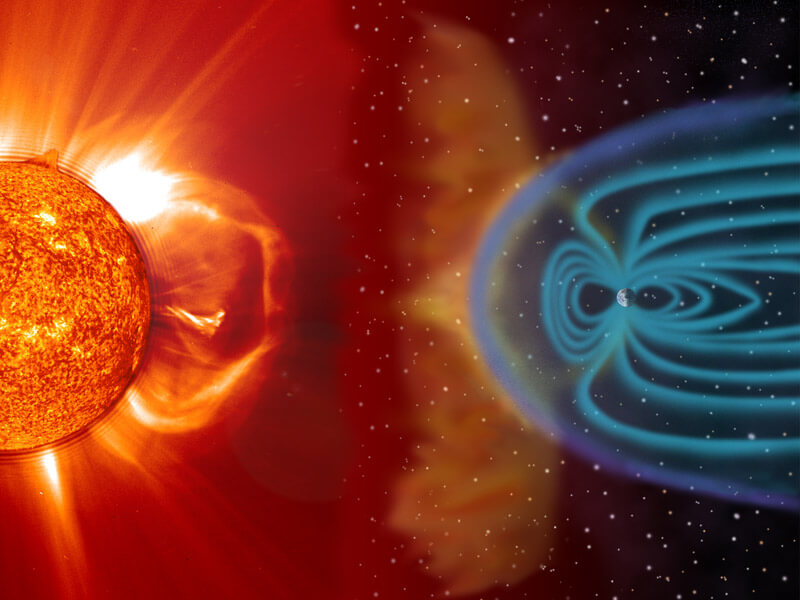
Effects of solar wind – Aurora
- An aurora is a natural light display in the sky, predominantly seen in the high latitude (Arctic and Antarctic) regions. (This is due to magnetic field lines of earth and solar wind)
- Auroras are caused by charged particles, mainly electrons and protons, entering the atmosphere from above causing ionisation and excitation of atmospheric constituents, and consequent optical emissions.

Effects of solar wind – Some planets have atmosphere whereas others don’t
- As the solar wind approaches a planet that has a well-developed magnetic field (such as Earth, Jupiter and Saturn), the particles are deflected.
- This region, known as the magnetosphere, causes the particles to travel around the planet rather than bombarding the atmosphere or surface.
- The magnetosphere is roughly shaped like a hemisphere on the side facing the Sun, then is drawn out in a long trail on the opposite side.
- The boundary of this region is called the magnetopause, and some of the particles are able to penetrate the magnetosphere through this region by partial reconnection of the magnetic field lines.
- The solar wind is responsible for the overall shape of Earth’s magnetosphere.
- Moreover, planets with a weak or non-existent magnetosphere are subject to atmospheric stripping by the solar wind.
- Venus, the nearest and most similar planet to Earth in the Solar System, has an atmosphere 100 times denser than our own, with little or no geomagnetic field. This is a strange exception.
- Solar flares are produced on the sun’s surface due to magnetic anomalies.
- They are magnetic storms which appear to be very bright spots with a gaseous surface eruption.
- As solar flares are pushed through the corona, they heat its gas to anywhere from 10 to 20 million °C.
- An arc of gas that erupts from the surface of the Sun is called solar prominence.
- Prominences can loop hundreds of thousands of miles into space.
- Prominences are held above the Sun’s surface by strong magnetic fields and can last for many months.
- At some time in their existence, most prominences will erupt, spewing enormous amounts of solar material into space.
- A corona is a distinctive atmosphere of plasma that surrounds the Sun and other celestial bodies.
- The Sun’s corona extends millions of kilometres into space and is most easily seen during a total solar eclipse.
- Sun’s Corona visible during Total Solar Eclipse

Sun’s Corona visible during Total Solar Eclipse
Plasma
- Plasma is one of the four fundamental states of matter, the others being solid, liquid, and gas.
- Plasma is ionised gas (atoms and molecules are converted into ions typically by removing one or more electrons from the outer shell)
- Lightning and electric sparks are everyday examples of phenomena made from plasma.
- Neon lights could more accurately be called ‘plasma lights’, because the light comes from the plasma inside of them.

